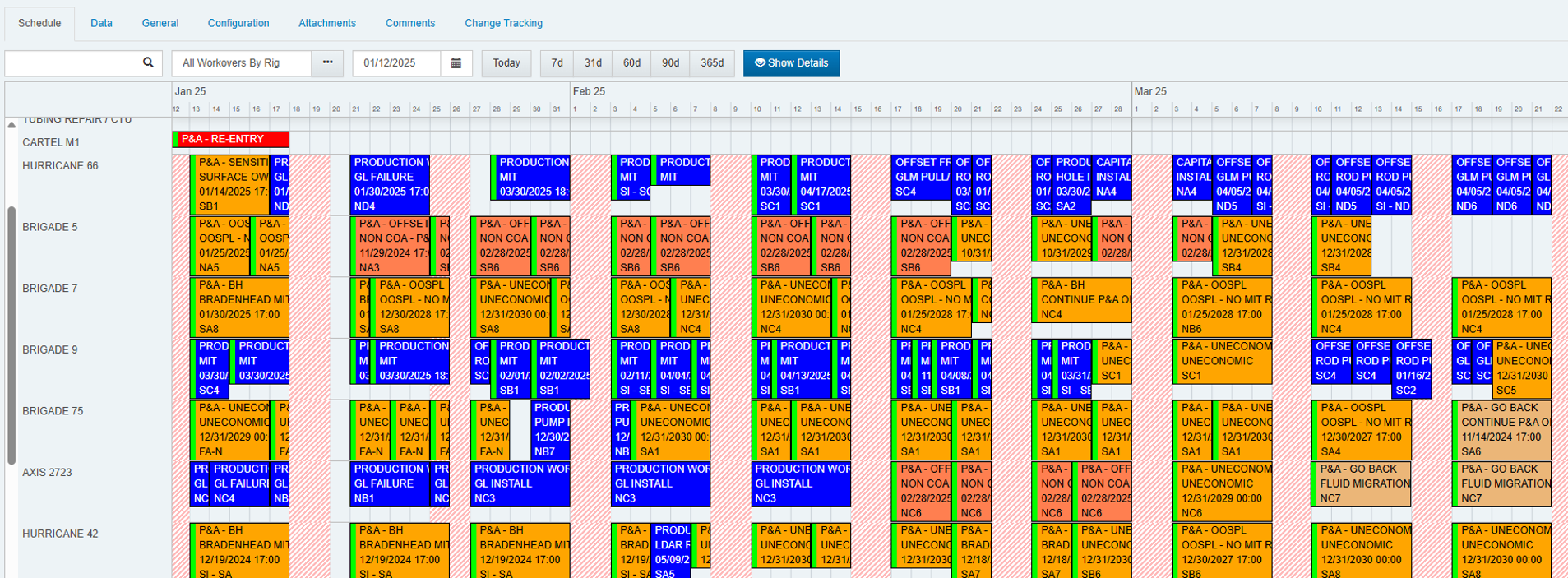Spreadsheets have long been the go-to tool for oil and gas planning. But when every team has its own version and no one’s sure which is current, they quickly become “load-bearing spreadsheets”: fragile, critical, and dangerously outdated.
Civitas faced rapid growth due to multiple acquisitions. Drill schedules, completion schedules, maintenance schedules, and workover schedules each lived in separate Excel files and legacy systems, and often dependent on the knowledge of a single person. Quorum’s Execute sought to modernize their well delivery and operational scheduling.
Part of a Bigger Integrated Upstream Suite
Civitas adopted Execute’s operational planning workflows within Quorum’s connected upstream ecosystem.
Quorum’s integrated upstream suite was built to bring planning, operations, and transactions together in one connected ecosystem. At the core is Quorum Execute, which unites capital management and operational planning. Execute bridges disciplines across finance, geology, engineering, land, HSE, and operations so teams work from a shared view of the plan.
Execute Core Modules
Operators can streamline AFEs, maintain accurate budgets, coordinate multi-discipline well delivery workflows, and manage all schedules from one source of truth. For Civitas, that meant moving from spreadsheets to connected planning—starting with Execute’s Well Delivery and Operational Scheduling modules.

Growing Pains in Multi-Basin Operational Planning
When Civitas expanded from operating solely in the Denver-Julesburg (DJ) Basin in Colorado into a multi-basin company, the multiple acquisitions brought together five former operators, each with its own systems and processes.
Civitas sought out an oil and gas operational planning software that could handle the scale and complexity of multi-basin coordination while providing a central source of truth.
Visual Scheduling and Accountability in Oil and Gas
One of Execute’s biggest wins at Civitas was its Gantt chart scheduling. Color-coded bars show job timelines, readiness milestones, and weekends, while red and yellow markers flag missing forms or data.
Schedulers and team leads use these visuals in weekly progression meetings to review outstanding tasks and update records directly. Over time, this built organic accountability, teams could see exactly how their timely updates kept projects moving.
Field schedulers were among the earliest adopters, drawn to the clarity of Execute’s visuals. “They have a nice visual,” Jenny said, noting how the Gantt chart quickly became a go-to reference during weekly operations meetings.

Beyond the Basics: Customization and Integration
Civitas has extended Execute beyond its out-of-the-box modules. For example, they built a custom offset frac tracking module within Execute, linked to wells, giving production engineers a dedicated space for related documents tied to the well record.
Civitas has already linked Execute with its accounting system to keep planning data aligned and is now preparing to extend those connections to well and land applications. Looking ahead, the team plans to expand its use of Quorum’s Data Hub so Execute data can flow seamlessly into other tools, giving users access without needing to log in directly.
Power BI for Cross-System Insights
Execute’s reporting API enables production engineers to feed data into Power BI dashboards, combining scheduling and planning data with ArcGIS maps and other sources. This creates a single, visual view that merges operational and spatial context for faster, better-informed decision-making.
Changing the Culture and Replacing Spreadsheets in Oil and Gas
One early adopter in the recon team demonstrated Execute’s value by moving his process for uploading site photos, reports, and attachments into the system. The change eliminated the frustration of digging through folders and emails, and his success story helped sell the system to others.
By positioning Execute as a central data repository and not a job replacement, Civitas built trust across teams. As more users experienced the benefits, resistance gave way to shared ownership of accurate, up-to-date information.
Civitas’ Results with Execute and What’s Next
Since adopting Quorum Execute for well delivery and operational scheduling, Civitas has:
- Replaced patchwork of spreadsheets with a single, shared platform
- Reduced schedule update and distribution time from hours to minutes — aligning with Quorum’s benchmark of 15 minutes to update and distribute the schedule
- Improved cross-department visibility and collaboration
- Reduced email volume and manual reconciliations — enabling real-time, spreadsheet-free scheduling
- Built a foundation for automation and cross-platform data flow
Phase Two will focus on adding targeted workflow automation, continue refining processes based on user feedback, integrating additional systems through Data Hub, and closing any remaining process gaps identified during the first phase of adoption.
From siloed spreadsheets to an integrated operational planning hub, Civitas’ Execute journey shows how starting light, focusing on adoption, and letting wins build momentum can transform planning and scheduling across the company.
Ready to replace your spreadsheets and streamline operational planning? Request a demo of Quorum Execute and see how you can connect capital management and operational planning in one platform.
 Previous Page
Previous Page